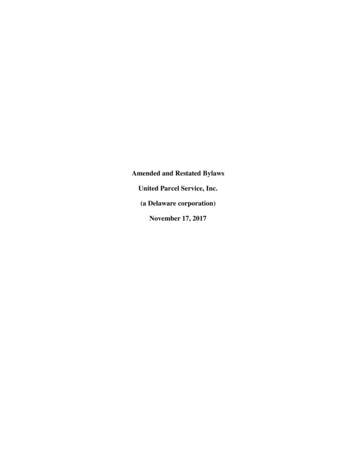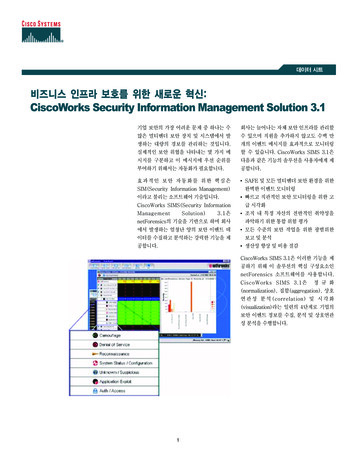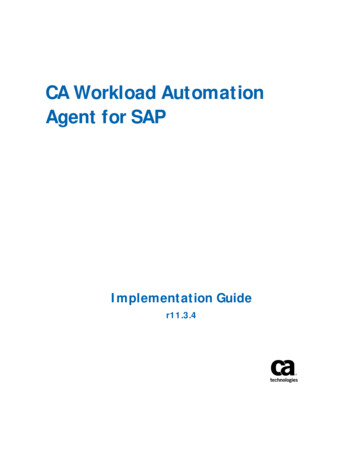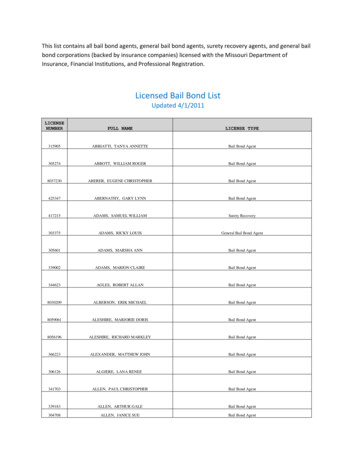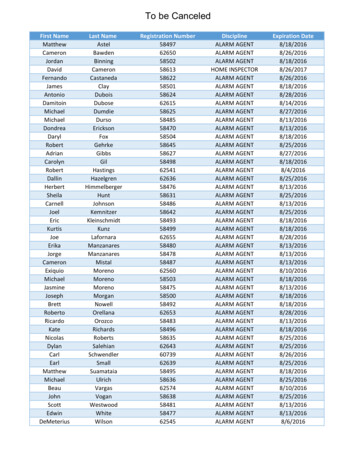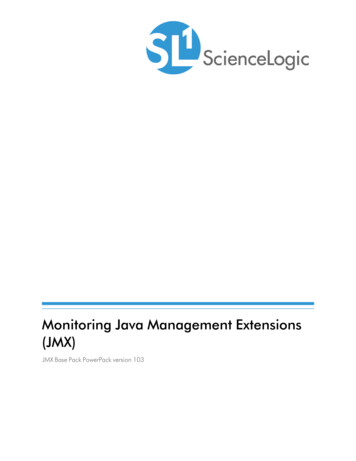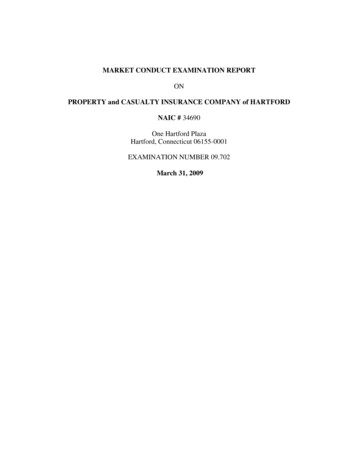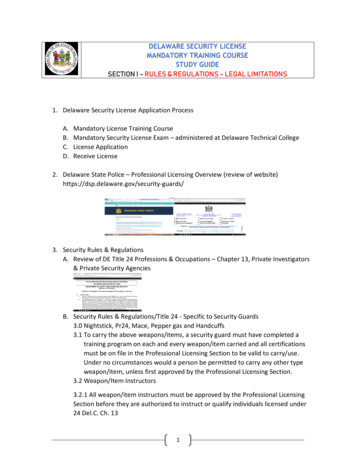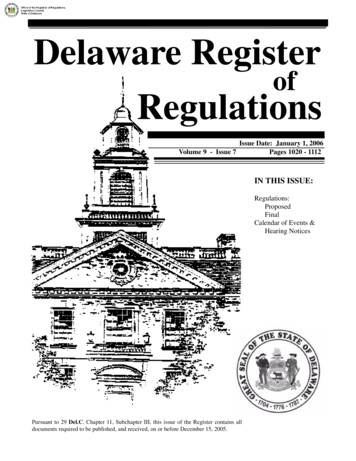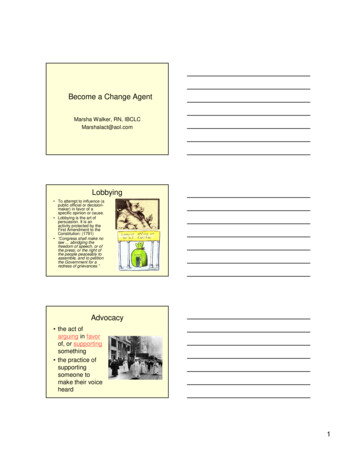
Transcription
Become a Change AgentMarsha Walker, RN, IBCLCMarshalact@aol.comLobbying To attempt to influence (apublic official or decisionmaker) in favor of aspecific opinion or cause. Lobbying is the art ofpersuasion. It is anactivity protected by theFirst Amendment to theConstitution: (1791) “Congress shall make nolaw abridging thefreedom of speech, or ofthe press; or the right ofthe people peaceably toassemble, and to petitionthe Government for aredress of grievances.”Advocacy the act ofarguing in favorof, or supportingsomething the practice ofsupportingsomeone tomake their voiceheard1
Speaking Up Lobbying or advocating is done by almost allspecial interest groups insures that our interests and concerns areheard, as well as competing interests and views,so that legislators have a broad base ofinformation on which to base their decisions. Lobbying attempts to persuade an individual,institution, or organization to support a certaincourse of action. You lobby when you encouragesomeone to agree to your way of thinking. We call ourselves “advocates” because we speakfor those whose voices are often silent –breastfeeding mothers and babies.Know What You Want What are your goals? Do you want to:––––Correct an injusticeInfluence policyCreate new legislationWork with the statedepartment of publichealth– Work at the local,state, or federal level Do you want toengage in indirectlobbying such aseducationalcampaigns (WorldBreastfeeding Weekfor instance) that aredesigned to mobilizepublic opinion anddeliver a message tolegislators and policymakers from a largepublic sector?Do Your Homework research on legislative, regulatory, andpolicy issues identify the critical players in the politicalarena who else is working on the similar issues professional associations legislative andpolicy agenda consider joining with others– State breastfeeding coalitions, Moms Rising,lobby days, listservs, professionalorganizations2
Follow the Money Learn to swim in themoney stream Federal dollars (WIC,federal healthagencies, Title V, NIHand other researchfunding Political contributionsto legislators Sponsorships ofprofessionalassociations Hospital incomesources Third party payers Employers Industry (formulacompanies)Who is Already Working onBreastfeeding Issues National Alliance forBreastfeedingAdvocacy US BreastfeedingCommittee State breastfeedingtask forces andcoalitions La Leche League Intl US Lactation ConsultantAssociation (USLCA) Academy ofBreastfeeding Medicine Local breastfeedingorganizations Breastfeeding advocacygroups– FirstRight.org WABAhttp://www.waba.org.my/Who Are the Players Grassroots lobbying candirectly affect actionstaken in Congress and ingovernmental agencies The daily business of theSenate and House iscarried out through theirrespective committees staff control the flow ofinformation to thelawmakers, advise themon issues, and influencetheir position on particularpieces of legislation Get to know these people Senate CommitteesSenate AppropriationsCommittee on the BudgetCommittee on FinanceCommittee on Labor & HumanResourcesHouse CommitteesHouse AppropriationsCommittee on the BudgetCommittee on Education &LaborCommittee on Energy &CommerceWays & Means Committee3
Federal Agencies USDA houses the WIC program DHHS has oversight responsibility for most ofthe other child health programs.– Maternal & Child Health Bureau (MCHB) contains theinfrastructure for delivery of health care services to allmothers and children in the US.– done through the MCH Services Block Grant, enactedin 1935, as Title V of the Social Security Act. MCHB also helps states in implementing otherrelevant legislation and in achieving the HealthyPeople 2010/2020 objectives for the nation thatrelate to maternal and child health.International BreastfeedingAdvocacy Tools Innocenti Declaration International Code of Baby Friendly HospitalInitiativeMarketing ofBreastmilk Substitutes International CodeDocumentation Center Protecting, Promoting, IBFAN (Internationaland SupportingBaby Food ActionBreastfeeding: TheNetwork)Special Role of– INFACT CanadaMaternity Services– National Alliance for– 10 Steps toBreastfeedingSuccessfulAdvocacy (NABA)BreastfeedingNational Alliance for BreastfeedingAdvocacy (NABA) IBFAN’s US organization Monitors the Code in theUnited States Sits on the USDA’sBreastfeeding PromotionConsortium Sits on the USBreastfeeding Committee Publishes US countryreports on Codeviolations4
National BreastfeedingAdvocacy Tools Surgeon General’s Report 1984Follow-Up Report 1985Second Follow-Up Report1991Healthy People 2000Healthy People 2010Call to Action: Better Nutritionfor Mothers, Children &Families Nutrition Action Themes forthe US: A Report in Responseto The InternationalConference on Nutrition The Child Nutrition Act– WIC Program Indian Health Care Act Social Security Act– Title V MCH Program Federal breastfeeding bills– Breastfeeding on federalproperty– Rep Maloney’s (D-NY)bills– Worksite section inhealth reform billFederal Register Published by the Office of the FederalRegister, National Archives and RecordsAdministration (NARA), the FederalRegister is the official daily publication forrules, proposed rules, and notices ofFederal agencies and organizations, aswell as executive orders and otherpresidential documents. http://www.gpoaccess.gov/fr/Centers for Disease Control andPrevention (CDC)– Infant Feeding PracticesStudy I and II– Breastfeeding report card– National ImmunizationSurvey– Maternity Practices inInfant Nutrition and Care(mPINC) survey– CDC Guide toBreastfeedingInterventions– Breastfeeding crib cards– http://www.cdc.gov/breastfeeding/5
Department of Healthand Human Services (HHS) Agency for HealthcareResearch and Quality(AHRQ)– Primary careinterventions to supportbreastfeeding– http://www.ahrq.gov/clinic/uspstf/uspsbrfd.htm– Breastfeeding andMaternal and InfantHealth Outcomes inDeveloped Countries– out/brfout.pdf National Women’s HealthInformation Center, Officeon Women’s Health http://www.4women.gov/ National BreastfeedingAwareness Campaign m?page Campaign HHS Blueprint forAction on Breastfeeding http://www.womenshealth.gov/pub/hhs.cfmNational Breastfeeding AwarenessCampaign (the one that got away!)HHS Office on Women’sHealth Toll freebreastfeeding helpline800 994-9662 Free publicationsEasy Guide toBreastfeeding inEnglish, for AfricanAmerican Women,for Native Americanwomen, Chinese6
Health Resources and ServicesAdministration (HRSA (HHS) Business Case forBreastfeeding Multifaceted approachto improving worksitesupport forbreastfeeding State breastfeedingcoalitions receivingtraining in implementingthis program http://ask.hrsa.gov/detail.cfm?PubID MCH00254&recommended 1Healthy People 2020 Healthy People provides science-based, 10-yearnational objectives for promoting health andpreventing disease. Since 1979, Healthy Peoplehas set and monitored national health objectivesto meet a broad range of health needs Objectives are currently being developed forHP2020– Increase the percentage of employers who haveworksite lactation programs.– Decrease the percentage of breast-fed newborns whoreceive formula supplementation within the first 2days of life.– Increase the percentage of live births that occur infacilities that provide recommended care for lactatingmothers and their babies. http://www.healthypeople.govUS Department of Agriculture USDA Breastfeeding Promotion Consortium The Breastfeeding Promotion Consortiumincludes more than 25 organizationsrepresenting health professional associations,breastfeeding advocacy groups and Federalagencies. The Consortium meets twice a yearto exchange ideas on how the FederalGovernment and private health interests canwork together to promote breastfeedingthroughout society7
Food & Nutrition Service WIC State breastfeeding coordinators “Loving Support MakesBreastfeeding Work” program USDA National BreastfeedingPromotion campaign Using Loving Support to buildbreastfeeding-friendly communities Using Loving Support to implementbreastfeeding peer counselors Fathers Supporting Breastfeeding MyPyramid for pregnancy andbreastfeeding Tips for breastfeeding moms Legislation for breastfeeding withinChild Nutrition Act (WIC) FNS breastfeeding mothers’ roomNew WIC food packages Provide incentives for initiation andcontinuation of bf Fully bf mothers receive more varietyand larger quantities of foods, plus a 10 voucher for fruits and vegetables. Fully bf infants get quantities, moretypes of baby food Minimize early supplementation withinfant formula No routine issuance of infant formula inbirth month to bf babies Partially bf infants get less formula Complementary infant foods areintroduced at 6 months of age. New Food Packages distinguishbetween the fully breastfed, partiallybreastfed & fully formula fed infant.Federal Trade Commission The FTC is charged with protectingconsumers from "unfair methods ofcompetition" and "unfair or deceptive actsor practices" in the marketplace it requires that all claims be nondeceptiveand substantiated in print ads, broadcastads, and on the Internet8
False and Misleading Advertising Report all false andmisleadingadvertising to the FTCat www.ftc.gov File a petition with theFTC to addressformula companydeceptive advertisingNational Quality Forum The National Quality Forum (NQF) created todevelop and implement a national strategy forhealth care quality measurement andreporting. http://www.qualityforum.org/ NATIONAL CONSENSUS STANDARDSFOR PERINATAL CARE– National Quality Forum endorsed 17 perinatalstandards to measure and thereby improve carereceived by mothers and babies during the thirdtrimester of pregnancy through hospital discharge.Consensus standards improve quality of care bystandardizing measurement in care settings andencouraging accountability and public reportingNational Quality Forum “Exclusive breastfeeding at hospital discharge” Measure description– Livebirths not discharged from the NICU whowere fed by “breast only” since birth. Function as perinatal standards forstandardized measures in the field of perinatalcare to assess and publicly report on the safetyand quality of care Perinatal standards measure care at criticalpoints for mother/baby from the third trimesterto hospital discharge and reflect aspects of carethat can be substantially influenced by providerperformance. Now part of the Perinatal Core Measure set9
US BreastfeedingCommittee Collaborative partnership of organizations and federalagencies www.usbreastfeeding.org Facilitates activities with all state breastfeeding coalitions Hosted 3 national state coalition conferences with leadersfrom every state, plus several territories and Indian Nations. With funding from the CDC, a new Coalition Mini-GrantsProgram to provide 18,000 in funding will support the workof state/territory/tribal breastfeeding coalitions. On-line advocacy platform Join the News and Action Alerts e-mail list to receive futureannouncements! p?key 394State Breastfeeding Coalitions ex.html Participate in bi-monthly conferencecalls facilitated by USBC and CDC work on– state legislation– breastfeeding advocacy– Business Case for Breastfeeding Provide a mechanism for advocacy inyour stateBan the Bags A project of the Massachusetts BreastfeedingCoalition www.banthebags.org Close to 400 hospitals have eliminated thedistribution of formula company dischargebags New York City has removed the bags from allpublic hospitals Portland, OR has no hospitals wherecommercial bags are distributed Used the state hospital (perinatal) regulationsrather than legislation10
Ban the Bags You may need– Ethics committee to provide opinion on the medicalethics of distributing formula samples– Risk management to decide if non-sterile powderedformula is safe to distribute without stock controlmechanism for recalled products– Corporate compliance for anti-kickback ruling– Marketing department, hospital auxiliary or foundationfor money to create hospital’s own discharge bag– Purchasing department to enforce vendor policy tokeep reps from bringing bags to maternity unit11
State BreastfeedingLegislation State Legislation that Protects, Promotes, and SupportsBreastfeeding (2005) USBC Protect, Promote, and Support Breastfeeding ThroughLegislation (2008) USBC 10 categories of state breastfeeding legislation Legislative recognition– Importance of breastfeeding contained in preambles tolegislation Breastfeeding in Public– Most frequent law that declares or clarifies a woman’sright to breastfeed in public– Often amends sections on indecent exposureState Legislation Employment– Break times– Unpaid breaks– Caveats, such as the employer is notrequired to provide break time if it disruptsoperations of the employer, or theemployer is held harmless if reasonableeffort has been made in complying,weakens the legislationState BreastfeedingLegislation Breastfeeding Promotion, Information,and Education– Several laws mandate thatbreastfeeding information be madeavailable at point-of-care locations– Some ask for a public educationcampaign Jury Duty– Various conditions are usuallydelineated on how a breastfeedingmother could be exempt from jury duty12
State BreastfeedingLegislation Family Law– 3 states have provisions regardingbreastfeeding in decisions on childcustody and visitation during divorce orseparation procedures Milk Banks– Texas has provisions for procurement,processing, distribution, and the use ofhuman donor milk by milk banksState BreastfeedingLegislation Nursing in prison– New York allows a nursing infant under 1 yearof age to accompany his mother in jail Breastfeeding Equipment/AssistancePrivileges– Maryland exempts breastfeeding equipmentfrom state sales tax– Texas requires that the health insurer of amaternity patient discharged before theminimum stay compensate the mother withcoverage of post delivery services includingbreastfeeding assistance, training, andconsultationsHospital Level Advocacy: Learn toWork the System Perinatal Practice CommitteeQuality Improvement DepartmentEthics CommitteeRisk Management DepartmentCorporate Compliance DepartmentMarketing DepartmentHospital auxiliary, foundationBilling DepartmentPurchasing Department13
Employers LegislationResearchCost effectivenessLetter from physicianUnionsChamber of CommerceBarriers to Corporate Lactation Programs Negotiation and prioritization of benefits (healthand non-health)– Lactation programs are in “competition” withimmunization, cancer treatment, vacation time, andsalaries Fairness doctrine– Issue of “extra breaks” & “special rooms”– What about safe, pleasant rooms for insulindependent diabetics or those with anxiety disorders, Hassle factor– Logistics, space, security– Coordination of time is difficult especially inregulated industries, plants, among small work units Liabilities– Milk storage/safety concerns (e.g., HIV,communicable diseases, etc)Lactation Program Benefits ByIndustryWholesale/Retail10%Service (P)27%Service (NP)M anufacture (NDG)25%5%M anufacture (DG)15%HealthGov40%4%Financial Services19%All19%Source: SHRM Benefits Survey 2005.14
Hints from the pros Educate women and men to stimulate demand– Learn from the pink bracelet Emphasize that lactation support isn’t just a“family-friendly benefit” it is a health benefit– Draw parallels between worksite lactation programsand well accepted health promotion and diseasemanagement programs Use medical evidence as a criteria for inclusionin benefit packages (women’s/human rightsperspective is important but isn’t salient to anemployer) Build the business case– Provide short and long term cost-savings/ healthimpact for baby and motherMaking the Case Businesses lose when employees don’tbreastfeed For every 1000 formula feeding babies, it isestimated that their mothers miss a total of a fullyear of employment in excess of breastfeedingmothers, to care for sick children (Ball andWright, Pediatrics, 1999) New mothers who aren’t breastfeeding have 3times as many 1-day absences from work asbreastfeeding mothers, because their childrenare sick more often (Cohen, Mrtek, Mrtkek, Am JHealth Promot, 1995)Breastfeeding mothers are good foremployers Absenteeism can cost more than 15% of acompany’s base payroll and up to 775 peremployee Investing in a company lactation program canresult in a 3 for 1 dollar return on investment Companies with lactation programs enjoy an 8090% retention rate of their maternity workforce. Employee turnover can cost 50,000 to replacea 50,000 employee15
Biggest “Barrier” Low Demand Benefits are crafted by cost, demand,voice-power, medical evidence, etc Employers provide (within reason) whatemployees value AND act on: manywomen are silent on the value of lactationrooms. There is a reason large employers aremore likely to offer “accupressure”benefits than lactation support (hint: it isn’ta medical reason)National Business Group on Health The National Business Group on Healthmembers are primarily Fortune 500companies and large public sectoremployers - including the nation's mostinnovative health care purchasers - whoprovide health coverage for more than50 million U.S. workers, retirees, andtheir families. The Business Groupfosters the development of a safe, highquality health care delivery system andtreatments based on scientific evidenceof effectiveness http://www.businessgrouphealth.org/Model Benefits Model benefitsresource ternalchild/investing/docs/mch toolkit.pdf16
Preventive Postpartum Care Recommends coveragefor 5 lactation consultantvisits per pregnancy lactation consultantscredentialed by theInternational Board ofLactation ConsultantExaminers (IBCLCs) areapproved for theprovision of breastfeedingcounseling, training, andsupport Lactation consultationvisits may be used at anypoint during pregnancyand in the year after birth These recommendationswere put forward by theUSBC and accepted intothe model benefitspackageInsurers:Getting their attention Tell insurers what they can do to “make adifference” in simple, actionable language– Baby-friendly hospitals Preferentially select baby-friendly hospitals andbirth centers for inclusion in health plan networks Provide incentives and rewards for beneficiarieswho birth at baby-friendly hospitals Reduced co-pays/co-insurance for servicesrendered at baby-friendly hospitals Educate beneficiaries on the importance ofbreastfeedingUsing the Media Media kitContacting reportersPitching your storyCareful use of languageTalking with reporters– Reframe, don’t react– “choice” is the language of breastfeedingopponents– Identify yourself as a health care provider Social media (Facebook, Twitter, etc) douts/tabid/163/Default.aspx17
Code MonitoringFeeding Bottles are Withinthe Scope of the Code Article 2. Scope of the Code The Code applies to the marketing, andpractices related thereto, of the followingproducts: breastmilk substitutes, including infantformula; other milk products, foods andbeverages, including bottle-fed complementaryfoods, when marketed or otherwise representedto be suitable, with or without modification, foruse as a partial or total replacement of breastmilk; feeding bottles and teats. It also applies totheir quality and availability, and to informationconcerning their use.Feeding Bottles Dr. Brown: “As close to breastfeeding as yourbaby can get” Avent: “Results more like breastfeeding than anyother bottle” Munchkin: “Match mom’s natural flow” Second Nature: “Truly works like mom’s breast”18
Breastfeeding promotion in thecommunityMarin Breastfeeding Coalition Library display ofbreastfeeding books Baby fairs Community babyshower at churches– Target high riskmothers Best for Babes19
Meanwhile . Nancy Mohrbacher calls regardingthe acquisition of Ameda by a companythat manufactures infant feeding bottlesand artificial nipples, asking if Iwould speak to this companyabout Code issues CEO of Evenflo states thatthey wish to become CodecompliantAddressing the Problem Ameda meets its obligations under theCode, Evenflo does not Effect on Ameda if Evenflo does not meetCode obligations The Code does not address the issue ofmergers and acquisitions How will engaging in Code compliantbehaviors affect Evenflo– Time– Expense– Reaction from the breastfeeding communityThe Road to Compliance Conversations and meetings to meshcorporate goals with what’s in the bestinterest of breastfeeding– Code compliance is in the best interest ofbreastfeeding– If Evenflo wishes to help promote andprotect breastfeeding than moving to Codecompliance fulfills this goal Education of employees andmanagement regarding the Code20
Easier Said than Done The Code can be quite vague and impreciseIt is a compromise documentIt is open to interpretationIt says very little about feeding bottles and artificialnipples The internet did not exist in 1981 Code interpretation and monitoring is subject toopinions, it can be interpreted in a narrow or broadmanner, and is often based on precedent Code compliance is a dynamic and fluid process thatis adhered to and monitored over timeSo Where Do We Start? Print ads in professionalor parent magazines hadbeen discontinuedseveral years earlier This ad was in the NewParent magazine in 2005 Since 2005 there hasbeen no directadvertising of bottles ornipples by Evenflo All print ads haveceasedWebsiteWHA Resolution 54.2 - 2001 “ despite the fact that the Code statesthat there should be no advertising orother forms of promotion of productswithin its scope, new moderncommunication methods, includingelectronic means, are currentlyincreasingly being used to promotesuch products ”21
Infant Feeding Information All infant feeding information (breast orbottle) was removed from the website,including handouts on breastfeeding forchildbirth educators to distribute to parents Evenflo does not produce any infant feedingbooklets, handouts, or publications forparents or health care professionals Only a referral listing for breastfeedingresources directs the public to noncommercial sources of breastfeeding helpPackaging Article 9.1 Labels should be designed toprovide the necessary information aboutthe appropriate use of the product, soas not to discourage breastfeeding Article 9.2 Neither the container nor thelabel should have pictures of infants,nor should they have other pictures ortext which may idealize the use of infantformulaThe Drop-Ins System is the only bottle that hasbeen clinically shown to help reduce gas, colic andspitting up. It is also clinically shown to mimicbreastfeeding. Additionally the liners and nipplesare Bisphenol-A Free and Phthalate Free.Research has shown us that most moms want theirbottle systems to do four things:1.Reduce gas and colic for baby2.Act like the breast so baby can go seamlessly frombreast to bottle with no confusion3.Pre-sterilized liners for a clean bottle every time4.Be easy to clean so she can spend more time withbabyThe Playtex Drop-Ins System has all four. Thissystem has been clinically shown to help reduce gas,colic and spitting up.Click here to see it in action.22
Criteria for Labels No idealization No comparisons to the real thing Contain warnings about inappropriateuse Contain instructions for proper use The information is informative andfactual Do not contain pictures of babies23
Consultation andCollaboration at its Best “Best for Babies” slogan on infant feedingproducts could be construed as implyingthat bottles/artificial nipples were better forinfants than breastfeeding– Evenflo changed this slogan to “BreastfeedingBest for Babies” and it will appear on allproducts covered within the scope of the Code(bottle and artificial nipple packages)– It will also appear on Evenflo breastfeedingproducts and accessories as reinforcement ofcompany’s commitment to breastfeedingOh Happy Day! With these changes Evenflo will be the firstand only bottle manufacturer to take thesesteps towards a genuine commitment topromoting breastfeeding by removingcommercial barriers to breastfeeding As a manufacturer and distributor of productsthat fall under the scope of the Code Evenflohas made significant changes in themarketing and labeling of these products inorder to meet its obligations under the Code,demonstrating its commitment to theprotection and support of breastfeeding24
- National Alliance for Breastfeeding Advocacy (NABA) National Alliance for Breastfeeding Advocacy (NABA) IBFAN's US organization Monitors the Code in the United States Sits on the USDA's Breastfeeding Promotion Consortium Sits on the US Breastfeeding Committee Publishes US country reports on Code violations

